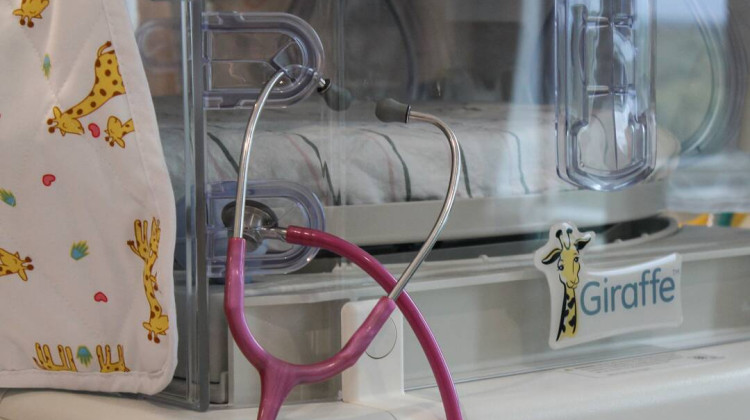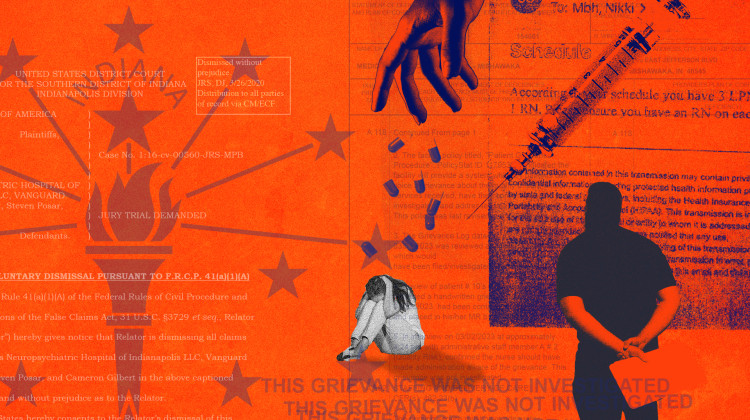
Sunday’s seven-day moving average is 590 percent higher than the rolling average when Indiana began Stage 5.
Lauren Chapman/IPB NewsThe Indiana State Department of Health reported 277 additional confirmed deaths over the last week, bringing the state’s total to 4,660 – the largest reported in a single week since early May.
After the state reported more than 6,000 new cases for the first time in a single day on Wednesday – less than a week after it passed 4,000 cases for the first time – it surpassed 8,000 new cases on Saturday. In the last week, the state has also reported more than 41,000 new COVID-19 cases, with more than 251,000 total confirmed cases.
The state has reported more than 2,000 cases every day since Oct. 22.
Sunday’s seven-day moving average is 590 percent higher than the rolling average when Indiana began Stage 5. The state’s hospital census has also set new highs for the last five days, with more than 2,500 Hoosiers hospitalized with COVID-19 since Nov. 10. The state began reporting hospital census data on April 8.
Here are your statewide COVID-19 headlines from last week.
Hoosier Hospitals Bear Brunt Of COVID-19 Surge: ‘It’s About To Become A Catastrophe’
Hoosier hospitals are bearing the brunt of Indiana’s surging COVID-19 case numbers.
Dr. Dale Patterson with Beacon Health System hospitals in the Elkhart-South Bend area said it feels like hospitals are constantly breaking records with the number of patients being treated for COVID-19.
Patterson said hospitals within the network have been on diversion, meaning they can’t accept ambulances, at times during the last couple of weeks. He said Beacon hospitals currently can’t take transfers, which is something they normally do – and having to implement those types of orders affects the quality of care residents in the area receive. COVID-19 is straining the system, he said.
“I don’t know what worst-case scenario looks like,” Patterson said. “I think we’re in the middle of a crisis that’s about to become a catastrophe.”
Holcomb Reimposes Limited COVID-19 Restrictions In Counties With Worsening Spread
Gov. Eric Holcomb announced Wednesday he will reimpose some COVID-19 restrictions on counties failing to control spread of the virus.
Holcomb’s new executive order comes after weeks of inaction in the face of worsening COVID-19 numbers.
The state will use the color-coded COVID-19 map it updates weekly to determine what restrictions counties face.
“If your county is in orange, social gatherings of any kind – indoors or outdoors – are limited to 50 people … if your county is in red, social gatherings of any kind – indoors or outdoors – are limited to 25 people,” State Health Commissioner Dr. Kris Box said.
But those restrictions don’t appear to apply to businesses or schools. And local health departments can still approve events that exceed those gathering limits, including sporting events.
Holcomb's Newly Public Order Illuminates Details On Enforcement, Restrictions
Gov. Eric Holcomb signed his latest executive order, with new limited COVID-19 restrictions. The order, made public Friday, includes more details on enforcement and how counties will move through those restrictions.
The new restrictions, announced Wednesday, are based on the color a county is designated on the state’s metrics map. The map is coded based on seven-day rolling averages and cases per 100,000 residents and is updated weekly.
The executive order outlines that counties must be designated a lower-risk color for two consecutive weeks before moving to fewer restrictions. However, counties will move immediately to more restrictive categories as the county’s designation worsens.
The map currently shows only five counties not subject to the new restrictions.
The newly-signed executive order also illuminates enforcement. The governor’s mask order focused heavily on education and charged local and county health departments with doing so. This newest order expands that to police, the Alcohol and Tobacco Commission and the Indiana Department of Homeland Security.
For businesses specifically, the executive order recommends issuing a verbal order, then an order to cease unsafe practices, and then an order to close the business if it doesn't comply. The executive order also suggests it could be referred to a local prosecuting attorney.
Though it is important to note, enforcement mechanisms remain optional.
Indiana Crosses 8,000 New Cases Saturday, Marking 7th New Record Set In November
Indiana set another record for daily reported cases of COVID-19, with 8,451 reported Saturday. The state has reported more than 4,000 cases every day since Nov. 4 and more than 2,000 every day since Oct. 22.
This newest record is the seventh such record in November. Indiana hit 5,000 new cases for the first time just a week previous, and crossed 6,000 cases on Wednesday. Saturday's record is the 15th since moving to Stage 5 on Sept. 26.
During that time, the state’s seven-day average for cases has increased by nearly 600 percent. The Indiana State Department of Health reported 1,270 new confirmed deaths, in addition to 24 probable deaths.
And 75 counties have more than doubled their cases, with Adams, Fountain, Randolph and Wabash counties at more than quadruple their totals from the previous six months.
New Restrictions To Slow Spread Of COVID-19 Means Fewer Sports Fans At School Games
With COVID-19 cases continuing to rise in Indiana, Gov. Eric Holcomb announced new restrictions for the hardest-hit counties, including limits on K-12 school events.
Indiana High School Athletic Association Commissioner Paul Neidig said he expected more restrictions on winter school sports – they'll be indoors, unlike most in the fall.
Neidig said it's vital for athletes and fans to follow health recommendations in their area to protect themselves, and the health of others. But he said, more COVID-19 cases could also mean canceled games – which takes opportunities away from kids.
"We cannot get that back – last spring was gone. I cannot recreate spring and bring it back for student athletes who missed that," he said.
Indiana Hospital Association Calls On Hoosiers To Help Curb Surging Rates
Indiana hospitalization rates due to COVID-19 reached their highest point on Thursday since the state began releasing that data. The Indiana Hospital Association, or IHA, says health care workers face a lot of uncertainties as case numbers continue to surge.
Laura McCaffrey, a spokesperson for IHA, said Hoosier hospitals will continue to have to make difficult decisions when it comes to providing health care if surging hospitalization rates don’t improve fast.
One major concern is the number of staff feeling worn out and overwhelmed. If these trends continue, McCaffrey said hospitals will face a staff shortage.
McCaffrey said she understands the importance of family-time over the holidays, the next month could prove critical to bringing hospitalization numbers down.
"I think one of my hospital members put it perfectly when he said, 'spare Thanksgiving to save Christmas,'" she said. "If we can all just kind of hunker down in the next month or so, that will make a really big difference."
Northwest Indiana Research Clinic Resumes Johnson & Johnson Trial
Johnson & Johnson has resumed its COVID-19 vaccine trial in northwest Indiana nearly a month after the company paused the study. In the Region, the study is being coordinated through Buynak Clinical Research in Valparaiso. The clinic is currently looking for participants for the trial.
Dr. Robert Buynak, owner of the research clinic and study facilitator, said study pauses speak to the importance of safety in trials because of how much attention is paid to the effects medications could have on participants. He said the news of early positive results of other vaccines and treatments indicates that vaccine work is headed in the right direction.
“I’ve done a lot of research studies over the past 20 years, and it’s not uncommon for any study, whether it’s a diabetic study or any type of study, to have a pause in enrollment while they look at any issues,” Buynak said.
He said increasing COVID-19 numbers in the Region also make vaccine clinical studies an option for those willing to go through the trial and who might not be able to get a vaccine in the first round of distribution.
Eli Lilly Gets Emergency Authorization From FDA For COVID-19 Antibody Treatment
The Food and Drug Administration (FDA) has given emergency authorization to Eli Lilly for its COVID-19 antibody drug bamlanivimab.
The Indianapolis-based company will be able to provide the treatment to mild to moderate COVID-19 patients who are 12 years and older and at high risk of it progressing to a more severe case and/or hospitalization.
Last month the U.S. government agreed to initially purchase 300,000 doses of the antibody therapy to distribute across the country pending FDA approval.
Manufacturing of bamlanivimab has been ongoing while the pharmaceutical company conducted trials of the drug with an expected 1 million doses of the antibody to be ready by the end of this year.
IU Experts Forecast Continuation Of Economic Recovery To Pre-Pandemic Levels In 2021
The small amount of economic growth Indiana University economists forecasted a year ago vanished with the pandemic. Authors of the 2021 forecast expect that it will take next year and beyond to fully recover.
The latest forecast from IU’s Kelley School of Business shows while most economic levels are returning to where they were pre-pandemic, unemployment numbers will lag through next year and likely not recover until sometime in 2022.
During a panel discussion, experts said it’s important that there’s an effort made to keep people healthy and safe from COVID-19, but also to try to avoid another shutdown. COVID-19’s effects have driven up unemployment rates and lowered interest rates.
Finance professor Cathy Bonser-Neal said while people might see Wall Street doing well, the S&P 500’s top five companies don’t show the full picture.
“There are some firms that have been highly rewarded, but as the Russell 2000 Index is also showing, there have been many companies in terms of market performance that have not recovered,” Bonser-Neal said.
Contact Lauren at lchapman@wfyi.org or follow her on Twitter at @laurenechapman_.
 DONATE
DONATE








 Support WFYI. We can't do it without you.
Support WFYI. We can't do it without you.